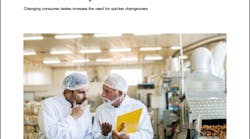Henry Ford once said, "You can have any color car you want, as long as it's black."
Do you think W. K. Kellogg ever said, "You can have any cereal you want, as long as it's corn flakes"?
Food and beverage manufacturing was probably never that simple, and it certainly isn't now. Today's consumers have more choices than ever -- and in regular, natural, organic and allergen-free varieties.
At the same time, the U.S. has the lowest-priced and most abundant food supply in the world, and one of the safest – credit at least part of all that to automation and other efficiencies. But variety – that means flexibility to manufacturers – usually runs counter to the high volumes that yield low costs. And the changeovers and other complexities required by variety can create food safety issues, too.
How can a food and beverage processor keep this all under control?
With the right ERP system, food processing professionals have the flexibility to transform their production lines to meet changing demands, while maintaining a high level of food safety, too.
In the early stages of managing a business, you can handle transactions between you and your customers, as well as between departments in your company, manually or with basic business software. At this early stage, the costs of adopting something more sophisticated outweigh the benefits.
But once a business starts to grow, two things happen. First, the volume of activity becomes more than you can reasonably handle with basic software, and administrative tasks start bogging down your operation because the current processes don’t scale well. Second, now that the business is well established and bumping up against larger competitors, it becomes important to get scientific about optimizing your operation for maximum profits.
That optimization depends, among other things, on keeping good records and collecting actionable insights from them.
Maneuvering around a problem rather than solving it creates only temporary solutions. Are you using one of these workarounds:
- Using bill of materials as a recipe?
- Using paper logs for traceability?
- Using excel for product costing?
Then you're not only lessening efficiency and flexibility, you're compromising food safety. It's time to look for an Enterprise Resource Planning (ERP) system … or to upgrade to a better one.


